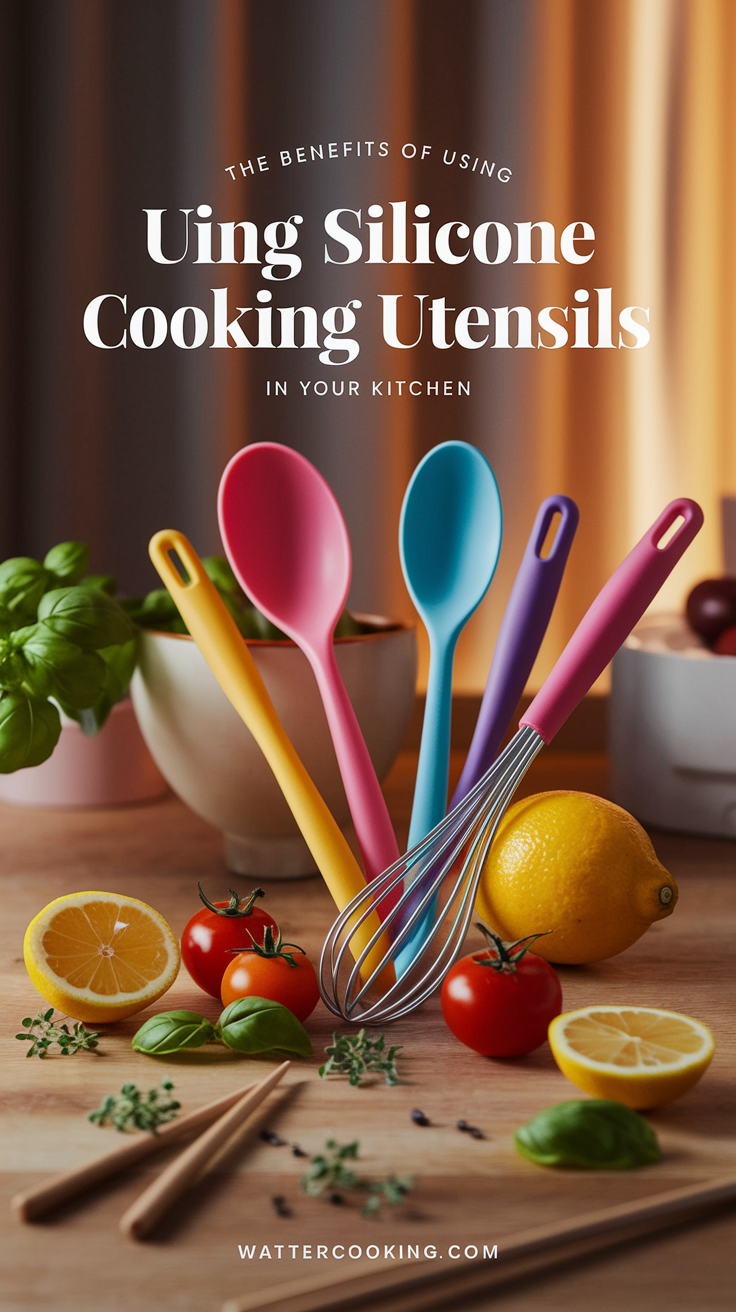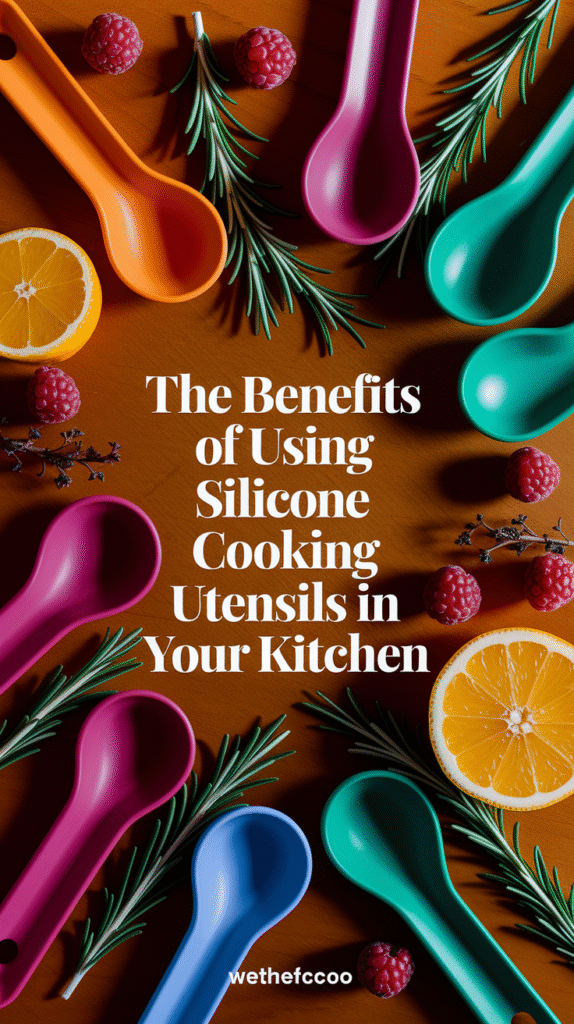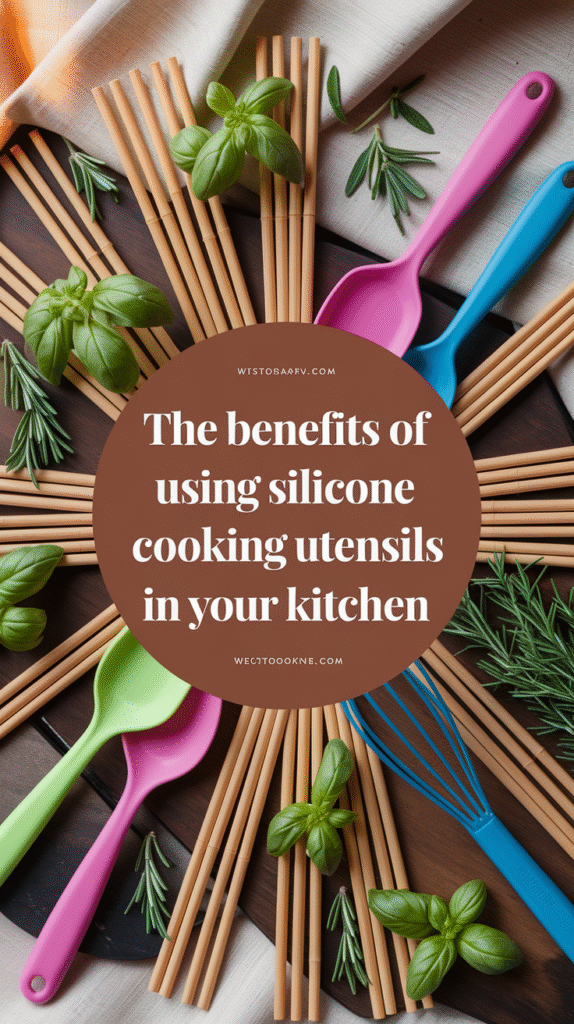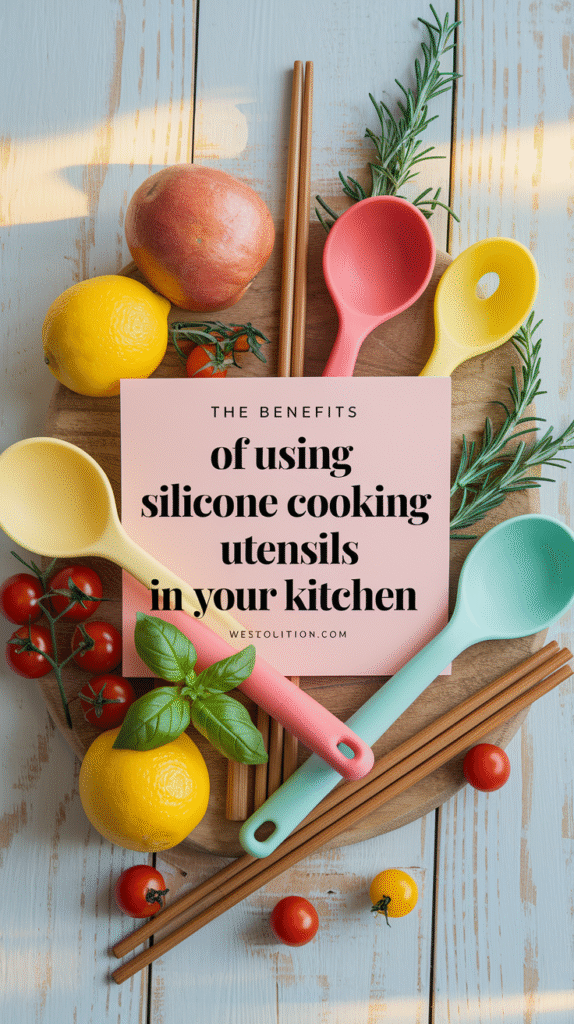In today’s kitchen, choosing the right utensils can make all the difference. Silicone cooking utensils have become increasingly popular, and for good reason. These tools are versatile, gentle on non-stick surfaces, and come with a range of benefits that can elevate your cooking experience. Here are some key advantages of incorporating silicone cooking utensils into your kitchen.
Durability and Longevity
One of the standout features of silicone utensils is their durability. Unlike wooden or plastic utensils that can break or warp, silicone is designed to withstand high temperatures and resist wear. You can use silicone spatulas and spoons for hot dishes without worrying about them melting or losing shape.
Additionally, silicone cooking utensils are generally stain-resistant and can last for years with proper care. This means fewer replacements and longer-lasting kitchen tools that remain effective through countless recipes.
Non-Stick Properties
When you cook, the last thing you want is to have your food stick to your utensils. Silicone cooking utensils excel in this aspect, providing non-stick surfaces that make flipping, stirring, and serving a breeze. You can easily remove delicate foods like eggs or pancakes without breaking them apart.
When used with non-stick cookware, silicone utensils help preserve the integrity of your pots and pans, minimizing scratches and damage. This combination not only enhances your cooking results but also extends the life of your kitchen tools.
Heat Resistance
Silicone cooking utensils are designed to handle high temperatures, making them ideal for various cooking methods. Most silicone can endure heat up to 500°F (260°C) or more. This property allows you to safely use the utensils in hot environments, such as when frying or baking.
Unlike wooden utensils which can warp or plastic ones that may melt, silicone retains its form and function even under extreme heat. This resilience is particularly valuable when juggling multiple tasks in the kitchen.
Flexible and Easy to Use
The flexibility of silicone utensils is another compelling benefit. This feature allows you to easily bend or maneuver spatulas, making it simple to scrape out bowls or jars without leaving a trace behind. You can efficiently mix batter or fold dough without much effort, improving your overall cooking experience.
Using silicone cooking utensils can make a significant difference in how effortless tasks become, letting you focus on the joy of cooking instead of grappling with cumbersome tools.
Easy to Clean
Maintaining cleanliness in the kitchen is vital, and silicone utensils shine in this area. Most silicone kitchen tools are dishwasher-safe, making cleanup a snap. If you prefer to wash by hand, they are equally easy to clean with warm soapy water.
Since silicone doesn’t absorb odors or flavors, there’s no risk of lingering tastes from previous meals. This feature stands out, especially if you switch between cooking different cuisines.
Health and Safety
Silicone cooking utensils are often made from food-grade silicone, ensuring they are safe for food handling. Unlike some plastic utensils, you won’t have to worry about harmful chemicals leaching into your food during cooking. This makes silicone a safe choice for you and your family.
Moreover, silicone utensils are free from BPA, making them an excellent option for the health-conscious cook. Choosing silicone means you prioritize not just effectiveness but safety as well.
Stylish and Colorful Options
Beyond practicality, silicone cooking utensils come in various colors and designs, adding a fun and vibrant touch to your kitchen. Whether you prefer classic shades or lively hues, it’s easy to find utensils that match your kitchen decor.
These eye-catching pieces can inspire creativity and elevate the aesthetics of your cooking space.
Silicone cooking utensils offer numerous advantages that enhance your culinary experience. Their durability, heat resistance, non-stick properties, and easy maintenance make them indispensable kitchen tools. With their blend of safety and style, it’s no wonder why more cooks are embracing silicone. If you’re looking to upgrade your kitchen essentials, consider investing in silicone cooking utensils for a modern, efficient cooking experience. For more tips on kitchen utensils, visit Epicurious and Food Network.
Comparing Silicone Utensils with Traditional Metal and Wooden Options
When it comes to choosing the right utensils for your kitchen, you often find yourself weighing the benefits of silicone cooking utensils against traditional metal and wooden options. Each type has its unique advantages and drawbacks that can influence your cooking experience. By understanding these differences, you can make a more informed decision that suits your cooking style.
Silicone cooking utensils have gained immense popularity in recent years, thanks to their flexibility and non-stick properties. Unlike traditional metal utensils, silicone tools are soft and flexible, allowing you to scrape bowls and pans without scratching the surface. They also work perfectly with non-stick cookware, making them a preferred choice for many home cooks.
One of the most appealing features of silicone utensils is their heat resistance. High-quality silicone can withstand temperatures ranging from -40°F to 450°F (-40°C to 232°C). In comparison, metal utensils can become extremely hot and conduct heat quickly, which can burn your hands if not handled carefully. Silicone stays cool during cooking, making it safer for you.
Here’s a quick comparison of silicone, metal, and wooden utensils:
| Feature | Silicone | Metal | Wood |
|---|---|---|---|
| Heat Resistance | Up to 450°F | Varies (can become hot) | Moderate (can scorch) |
| Non-Stick | Yes | No | No |
| Durability | Very Durable | Durable, prone to bending | Can crack or warp |
| Maintenance | Easy to clean, dishwasher safe | Requires careful cleaning | Requires hand washing |
Silicone utensils are typically more resistant to stains and odors compared to wooden utensils. Wooden tools may absorb flavors and sometimes warp or crack, especially after repeated exposure to water. On the whole, silicone offers a quick and easy way to keep your kitchen tools clean and fresh.
Another point worth considering is how silicone utensils stand up to everyday use. While metal utensils can bend or become deformed with continued use, silicone tools maintain their shape and strength over time. This durability means that investing in quality silicone cooking utensils is generally worth it, providing you with long-lasting kitchen essentials.
However, there are some downsides to silicone utensils. For instance, they may not have the same weight or “feel” that metal utensils do when you’re cooking. Many chefs prefer the sturdiness of a metal spoon when stirring up heavier mixtures. Additionally, silicone can sometimes leave a slightly elastic feel when mixing, which some people may find less appealing.
Wooden utensils offer a classic touch and are often favored for their aesthetic appeal. They are biodegradable and generally more gentle on non-stick cookware. However, one must invest in proper maintenance practices, as wooden tools can harbor bacteria if not cared for properly. Regular oiling and immediate cleaning after use can help prolong their lifespan.
If you find yourself frequently cooking a variety of dishes, consider the following tips when selecting your utensils:
- For delicate tasks like flipping pancakes or stirring sauces, silicone cooking utensils are ideal.
- For grilling or frying, metal utensils might be more suited for handling hotter temperatures.
- Using a mix of all three—silicone, metal, and wooden utensils—can cover all bases for cooking, baking, and food preparation.
Ultimately, the choice between silicone, metal, and wooden cooking utensils comes down to your personal cooking style and preferences. For more information on the benefits and uses of silicone utensils, you might want to visit Silicone Kitchenware.
Understanding the strengths and weaknesses of each material can help you optimize your kitchen experience. Silicone cooking utensils provide versatility, safety, and easy maintenance, while metal and wooden options each lend their character and durability to culinary tasks. Make the best choice by evaluating what tools suit your cooking habits and preferences the most.
How to Properly Care for and Maintain Your Silicone Cooking Utensils
Silicone cooking utensils are a favorite among many home cooks and professional chefs alike. These versatile tools are not only durable, but they also protect your cookware from scratching and damage. To ensure your silicone utensils maintain their quality and longevity, proper care and maintenance are crucial. Here’s how you can keep your silicone cooking utensils in top shape.
Cleaning Your Silicone Utensils
Cleaning your silicone utensils is straightforward. The great news is that silicone is dishwasher safe, but there are a few things you should keep in mind:
- Place your silicone utensils on the top rack of the dishwasher.
- Avoid using harsh detergents that can cause wear over time.
- If you prefer washing by hand, use warm soapy water and a non-abrasive sponge.
Removing Stains and Odors
Sometimes, your silicone utensils may retain stains or odors, especially after cooking rich foods. To combat this, you can:
- Soak the utensils in a mixture of baking soda and warm water for 30 minutes, then rinse thoroughly.
- Use a mixture of vinegar and water to wipe down the utensils, which can help eliminate odors.
- If stubborn stains persist, try washing them with a gentle scrub brush or cloth.
Storing Your Silicone Utensils
Proper storage not only helps preserve the shape of your silicone cooking utensils but also keeps them organized. Here are some tips for storing them effectively:
- Keep them in a drawer or a container away from direct sunlight to prevent fading.
- If you hang them, ensure they are not tightly packed to avoid warping.
- Consider using a utensil holder to keep them accessible and handy on your countertop.
Avoiding High Temperatures
Silicone utensils are heat resistant, but it’s essential to know their limits to avoid damaging them. Most silicone utensils can withstand temperatures up to 450°F (232°C). Here’s how to keep them safe:
- Avoid leaving your silicone utensils in a hot pot or an oven.
- Use them only for cooking on medium to low heat settings.
Checking for Damage
Regularly inspect your utensils for any signs of wear and tear. Look for:
- Cracks or tears that could cause pieces to break off.
- Discoloration that may indicate degradation.
If you notice any significant damage, it’s best to replace the utensil to ensure safety while cooking.
Benefits of Using Silicone Utensils
Aside from their ease of use and maintenance, silicone cooking utensils offer various benefits:
- Non-stick surface, making cooking and cleaning easier.
- No chemical leaching into food, making them a safer choice compared to plastic utensils.
- Flexible and durable, allowing you to scrape and mix with precision.
Where to Buy Quality Silicone Utensils
Investing in high-quality silicone utensils will save you time and enhance your cooking experience. Look for trusted brands and retailers. Some great places to start include:
By following these care and maintenance tips, you can ensure that your silicone cooking utensils remain functional, attractive, and safe to use for many cooking ventures ahead. They’re flexible, versatile, and safe—qualities that make them indispensable in your kitchen!
Creative Uses for Silicone Utensils Beyond Cooking
Silicone utensils are not just for cooking anymore. With their versatility and durability, they can be creatively utilized in a variety of ways around your home. Here are some innovative uses that can enhance your daily life.
Crafting and DIY Projects
Silicone utensils are perfect for various crafting projects. Their flexible design makes them ideal for stirring, mixing, and pouring materials. Here are some crafty ideas:
- Mold Making: Use silicone spatulas to apply resin or other materials into molds. Their heat resistance ensures no melting while you work.
- Paint Applicators: Silicone brushes can be effective for applying paint on canvases and walls. They are easy to clean and don’t retain moisture.
- Sculpting Tools: Use silicone spoons or spatulas for shaping clay or dough. Their flexibility helps in creating intricate designs.
Beauty and Skincare
Silicone utensils can double as beauty tools. They help in applying beauty products smoothly and evenly. Here are some popular uses:
- Facial Masks: Use a silicone brush to apply masks evenly across your face, ensuring thorough coverage without wasting product.
- Hair Dye Application: Silicone spatulas are perfect for applying hair dye. Their non-porous surface helps keep colors from mixing.
- Skincare Savvy: Apply serums and lotions using a silicone applicator. It reduces the chances of transferring bacteria from your fingers to your skin.
Home Organization
Silicone utensils can be used beyond the kitchen to help organize your home. They are perfect for keeping small items neat and tidy:
- Drawer Dividers: Cut long silicone spatulas to size and use them to create compartments in drawers. This keeps your utensils and tools organized.
- Coasters: Use silicone trivets as coasters to protect your furniture from heat and moisture.
- Cable Management: Employ silicone clips to manage charging cables and cords. They keep your cords untangled and easy to access.
Children’s Activities
Silicone utensils are wonderful for kids’ activities. Their safe, soft surfaces make them ideal for playtime:
- Sand and Water Play: Use silicone scoops and buckets for outdoor sand and water play. They are durable and resistant to wear.
- Art Projects: Kids can use silicone spatulas to create patterns with paint or play dough without the worry of breaking them.
- Snack Time: Silicone utensils can serve as fun scoopers for snacks, making it a playful way for kids to enjoy their food.
Creative Gifting
Have you ever thought of using silicone utensils as gifts? They’re practical and fun!
- Gift Baskets: Create a cooking or crafting gift basket filled with various silicone utensils. It’s a thoughtful present for your creative friends.
- Party Favors: Offer mini silicone spatulas or brushes as creative party favors for birthdays or themed events.
- Personalized Gifts: Consider customizing a silicone utensil with names or quotes for a unique touch.
Cleaning Hacks
Cleaning silicone utensils can also lead to creative hacks around the house:
- Stain Removal: Use silicone brushes to apply stain remover directly to fabric. Their flexibility makes them great for getting into hard-to-reach areas.
- Dusting: On high countertops, use silicone mitts for dusting. Their grip helps catch dust without scratching surfaces.
- Window Cleaning: Employ silicone scrapers for cleaning windows and tiles without leaving streaks.
Silicone cooking utensils have numerous creative uses beyond the kitchen. Their flexibility, durability, and easy cleaning make them indispensable tools in various aspects of your life. Whether for crafting, beauty, or home organization, silicone utensils can enhance your daily tasks.
For more information about silicone utensils and their creative uses, consider exploring Silicone Products or Better Homes & Gardens’ guide to silicone cookware.
The Environmental Impact of Choosing Silicone Cooking Utensils Over Plastic
When it comes to choosing cooking utensils, the materials they are made from can significantly impact our environment. Silicone cooking utensils offer a greener alternative to conventional plastic utensils, making a considerable difference in reducing waste and pollution. Understanding this impact can help you make informed choices about your kitchen tools.
Silicone is derived from silica, a natural element found in sand and quartz. Unlike plastic, which is made from petroleum, silicone is more sustainable and has a lower environmental footprint. Here are some key benefits of opting for silicone utensils:
- Durability: Silicone is highly durable and heat-resistant, often lasting for years with proper care. This longevity reduces the need for frequent replacements, which is a common issue with plastic utensils.
- Non-Toxic: Silicone cookware doesn’t leach harmful chemicals into food, unlike some plastics that can release toxins when heated. This makes silicone a healthier option for both you and the planet.
- Ease of Recycling: At the end of their lifespan, silicone utensils can be recycled more effectively than plastic. Many recycling programs are now accepting silicone, diverting it from landfills.
- Eco-Friendly Production: The manufacturing process for silicone utilizes energy-efficient methods. Furthermore, many brands are committed to sustainable practices that minimize environmental harm.
You might wonder how silicone utensils compare to plastic ones in terms of environmental impact. Here’s a straightforward comparison:
| Feature | Silicone | Plastic |
|---|---|---|
| Durability | High, lasts multiple years | Moderate, tends to break or wear out quickly |
| Heat Resistance | Up to 500°F (260°C) | Varies, often lower than silicone |
| Toxic Release | None | Potential leaching of chemicals |
| Recyclability | Yes, accepted in some programs | Limited recyclability, often ends up in landfill |
When selecting silicone utensils, pay attention to the quality. Not all silicone is created equal; some may include fillers that diminish their eco-friendliness. Look for food-grade silicone products, which are free from BPA and other harmful substances. Brands that prioritize sustainability often indicate this on their packaging or website.
Transitioning to silicone cooking utensils can be an excellent choice for individuals committed to reducing their environmental impact. Here’s how you can make the switch:
- Start Small: Replace a few plastic utensils with silicone options. For example, swap your spatula or spoon first.
- Research Brands: Look for reputable brands that specialize in high-quality silicone kitchenware, such as Food Network or Silicone Spas. These brands often have eco-friendly certifications.
- Educate Yourself: Engage in learning about the broader environmental impacts of materials in your kitchen. Resources like Greenpeace can provide valuable insights.
It’s also important to note that the disposal of silicone utensils should be approached with care. While silicone is more environmentally friendly compared to plastic, it’s not biodegradable. Therefore, always check local guidelines for recycling silicone products.
Implementing silicone cooking utensils in your kitchen can lead to a noticeable reduction in your environmental impact. By choosing materials that are safer, more durable, and easier to recycle, you contribute to a healthier planet. Every small change can create a ripple effect in promoting sustainability, encouraging others to follow suit.
Conclusion
Silicone cooking utensils offer a versatile and practical addition to any kitchen, making meal preparation easier and more enjoyable. Switching from traditional metal and wooden utensils to silicone can revolutionize your cooking experience. With their heat resistance, non-stick properties, and durability, silicone utensils reduce the risk of scratches on your cookware and promote healthier cooking without added chemicals.
Proper care and maintenance of your silicone utensils are simple yet essential for prolonging their lifespan. By hand-washing or placing them in the dishwasher, you can ensure they stay clean and functional for years to come. Their adaptability also makes them ideal for creative uses beyond mere cooking, such as crafting, baking, or even home organization.
Moreover, choosing silicone over plastic is a conscious decision that positively impacts our environment. Silicone is a more sustainable option that doesn’t leach harmful chemicals into your food or contribute to plastic pollution. By investing in silicone utensils, you’re not only enhancing your cooking but also taking a stand for a healthier planet.
Silicone cooking utensils into your kitchen likely brings a host of benefits, from ease of use and safety to environmental consciousness. With their numerous advantages, it’s clear that silicone utensils are a wise choice for both seasoned chefs and home cooks alike. Embrace silicone cooking utensils today and transform your culinary adventures while making a positive impact on your kitchen, the environment, and your overall cooking experience.







Leave a Reply